Last updated: January 12, 2024
Article
The Oasis Newsletter: Spring 2021

Connecting with Park Staff to Build Relationships and Improve Outreach
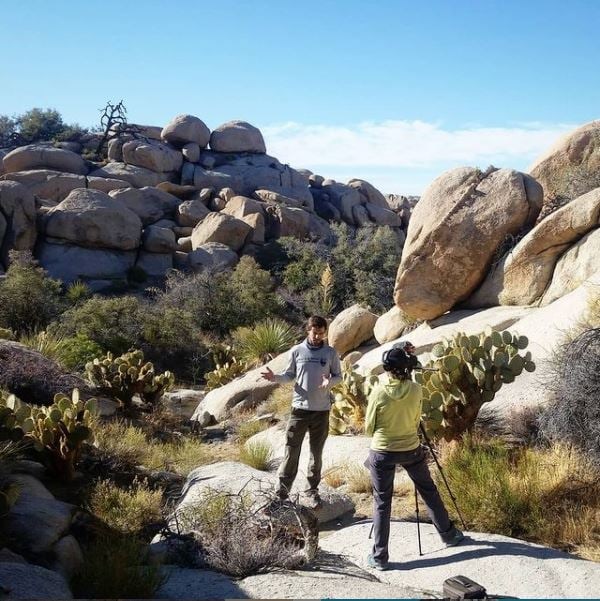
NPS / Marisa Monroe
As we are a program that conducts monitoring projects in seven Mojave Desert Network (MOJN) national parks or monuments, we don’t have a lot of opportunities to interact directly with many of the staff in each park, particularly in the past year. In the past months, MOJN staff have been reaching out to some of the interpretive staff and social media teams in a few of our parks. These efforts have included Microsoft Teams remote meetings with a few interpreters at Death Valley, Joshua Tree, and Lake Mead to get acquainted, a collaborative video project and social media posts with Joshua Tree, visit posters from field crews to interpreters prior to field sampling trips, and a few interpreters or other staff joining crews in the field.
We share highlights from these efforts below. Please reach out to Science Communication Specialist Linda Mutch, or Program Manager Allen Calvert if you would like to join a crew in the field, work with us on social media, or explore ways to engage in some science or natural resource outreach opportunities together in the future.
New Video: Why Monitor Desert Springs?
We thank Peri Sasnett, a videographer from the Joshua Tree National Park social media team, for opportunistically joining Physical Science Technicians Logan Combs and Marisa Monroe in the field last December to create a short video. The three-minute video shows how desert springs are monitored, why they are important to desert plants and animals, and why these jobs can be fun, challenging, and rewarding. We also thank Emily Hassell, Lead Social Media Specialist at Joshua Tree, for her support of this project. Watch the video, and enjoy! An audio-described version is also available.
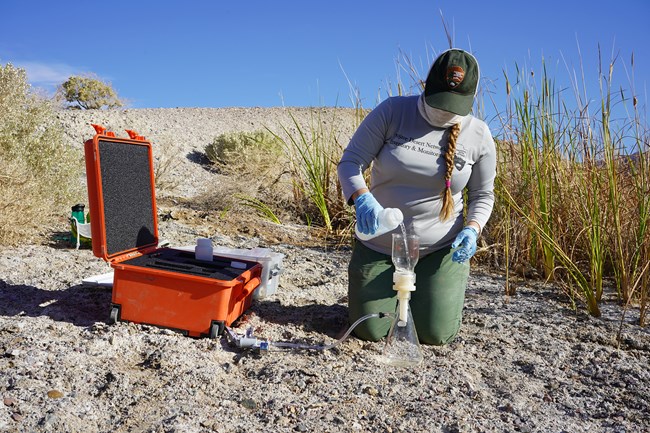
NPS photo / Jennette Jurado, Death Valley National Park Supervisory Ranger
Visit Flyers and Joining Crews in Field
Thank you to MOJN Biological Science Technician Joseph Ladd for initiating visit flyers – colorful, 1-page brief overviews of what a monitoring crew will be doing in a particular park for a multi-day monitoring visit. These are typically sent out ahead of time to district interpreters and other park contacts, as well as occasionally handed out as hardcopies to park staff when possible. They raise awareness of what we are doing in parks and offer an opportunity to those who may be interested in joining a crew in the field. Thanks also to Physical Science Technician Marisa Monroe for initiating numerous meetings and conversations with interpreters in multiple parks to seek avenues for working together or having staff join crews in the field.As a result of visit flyers and reaching out, numerous staff from Death Valley and Joshua Tree have been able to join desert springs or vegetation monitoring crews in the field recently. Thank you to Jennette Jurado, Supervisory Park Ranger at Death Valley for spending a day at Travertine Spring with MOJN staff and providing us with some photos of monitoring in action. We also thank Death Valley Resource Management staff Shannon Mazzei and Emmons McKinney who assisted us with desert springs monitoring that week, and Owen Hardy who lent a hand at Panamint Burro Spring. In Joshua Tree, Amanda Pascali, Scientist-in-the-Parks Intern, helped us map pools at 49 Palms, and Simone Steger, Interpretive Park Ranger, helped with Integrated Uplands vegetation monitoring for a day. These days in the field with park staff are a great opportunity to learn about each other’s programs. Thank you for joining us!
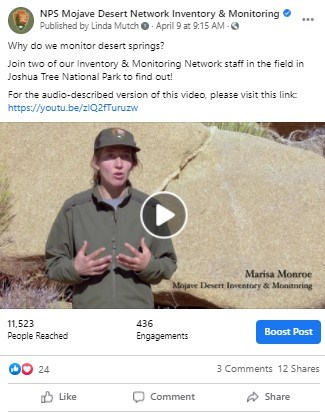
Benefits of Collaboration on Social Media
We aim for 1-2 posts per week on our Facebook and Instagram accounts and typically post to highlight fieldwork, share communication products and activities, or feature natural history information about parks. While we have gradually been increasing our audiences – up to 1866 followers for Facebook and 3724 for Instagram – these audiences are much smaller than those of large parks. When Joshua Tree social media staff have shared a couple of our posts recently, we have gone from reaching hundreds of people to reaching over 10,000 with those posts. We are interested in having network parks occasionally share posts that would be of interest to park audiences, as well as working with parks to develop natural history or science posts related to our monitoring or other topics of interest. Please reach out to Linda Mutch if interested in social media collaborations with us.
NPS / Allen Calvert
Bug Booth Hosted at Junior Ranger Day
Mojave Desert Network Physical Scientist Jennifer Bailard and Physical Science Assistant Clarice Wheeler had a great time at Junior Ranger Day in Lake Mead National Recreation Area on April 24th. They hosted MOJN's traditional “bug booth,” where young scientists were able to look at springsnails through the microscope and find other water-dwelling organisms in sample trays. They appreciated everyone who braved the wind and brought their families, scout troops, and school groups to the event!
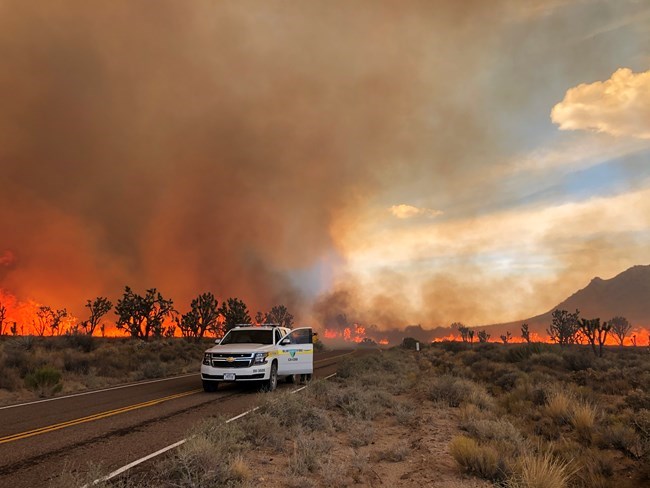
NPS / JT Sohr
Over 1 Million Joshua Trees May Have Died in Dome Fire
Last August, the Dome Fire, ignited by lightning in a wilderness area, spread rapidly through Joshua tree woodlands in Mojave National Preserve. An estimated 1.3 million Joshua trees were killed in the fire, as well as many other cacti, shrubs, and herbaceous plants. While many plants are adapted well to re-seed or sprout after fire, it is unlikely many of the Joshua trees will recover as the fire fully scorched most of the vegetation in the burn area. While Joshua trees with the top third of their crown unburned may have a chance to survive, fully scorched trees die.The Dome Fire was reported on August 15, when many other fires were burning in California. Initial requests for fire-fighting resources such as aircraft, engines, and additional crews were denied. Other fires burned in more populated areas, threatening infrastructure, homes, and businesses. Thus, the Dome Fire, being in a desert wilderness, ranked as a lower priority for limited firefighting resources. A local fire crew responded immediately, assessed the fire, and began work to protect historic structures.
On August 16, the fire spread rapidly under extreme conditions. A convection column rose above the fire and collapsed, creating downdrafts and fire whirls. The biggest loss of natural and cultural resources occurred that day, but there were no injuries to firefighters or to residents who had to evacuate. After an interagency team arrived on August 17, additional resources became available to help control the fire. By the time the fire was contained, it had burned 43,273 acres.
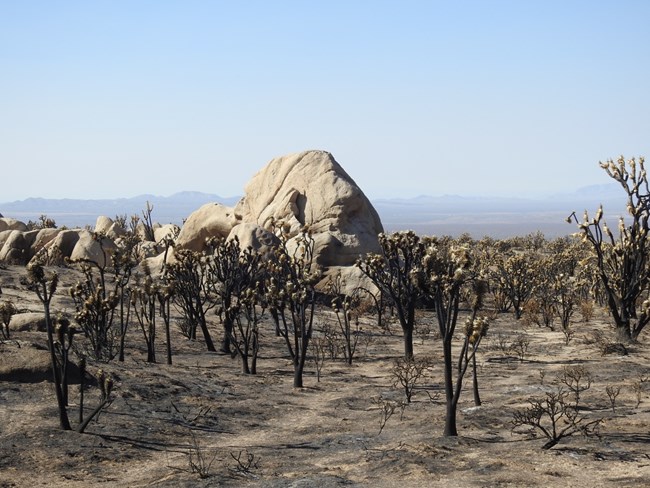
NPS / Barbara Michel
Looking to the Future
Certain plants in the area may still have surviving root systems, and with rainfall and time, may re-sprout. Seeds of many other species are competing for limited resources.After severe fires elsewhere in the desert southwest, invasive grasses (such as red brome, Bromus rubens) have grown in thick and created a fire-grass cycle. These invasive grasses cause larger and more frequent fires by adding continuous fuels to the space between shrubs and cacti. They then regenerate post-fire, creating an on-going fuel source for future fires.
Long-term monitoring is critical to understanding the post-fire response of vegetation. Mojave Preserve staff regularly monitor the interactions between native and non-native vegetation, and they are preparing mitigations (including direct seeding, transplanting, and herbicide application), should they be necessary to restore native plants and control invasive ones.
The Mojave Desert Network (MOJN) monitors two springs within the burn area. MOJN Physical Scientist Jennifer Bailard said she is curious to see how these springs look when they next visit them (scheduled for early 2022).
"Both springs had wooden structures that facilitated the discharge of water at the surface," Jennifer said. "If those structures were burned, then the location of discharge may have shifted, flow might be reduced, or water may no longer reach the surface. Additionally, both springs were fairly small to start out, with at most 15 meters of springbrook length observed during our winter visits."
Monument staff are hopeful that this landscape will transition to a Joshua tree/grassland savanna, with widely spaced Joshua trees or Junipers and native perennial shrubs and bunchgrasses in between them. However, it will be critical to prevent reburn of the affected area.
Much of this article was excerpted and adapted from this Mojave National Preserve web page. Visit this page to learn more about fire effects on plant and animal life and cultural resources, and more detail about potential recovery of this landscape.
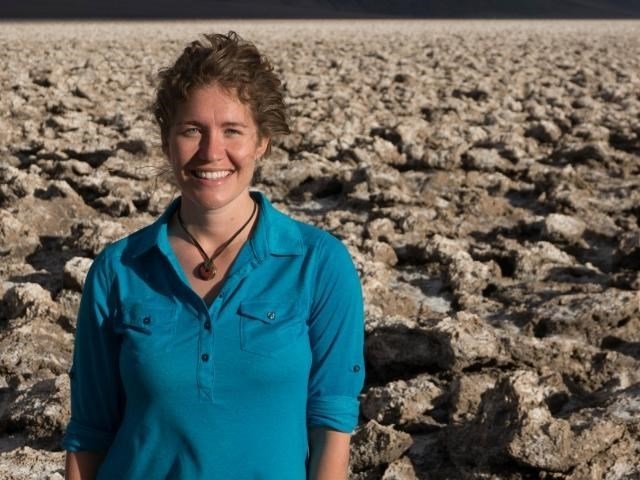
Staffing Updates
Nicole Hupp
We bid farewell to Nicole Hupp, Mojave Desert Network (MOJN) Ecologist, in January when she left for a new position as Geospatial Ecologist with the Bureau of Land Management Montana/Dakotas State Office. She is based in Missoula, Montana and her work focuses on the Assessment, Inventory, and Monitoring strategy for assessing natural resource condition and trends, sage grouse habitat management, and science in general at field offices across the region.Nicole began working with Mojave Desert Network in 2015 as a cooperator, and formally joined the team as an ecologist in 2016. Nicole was project lead on all of the vegetation monitoring protocols, which included integrated uplands, desert spring vegetation, aspen, white pine, and invasive plant species early detection. She developed new monitoring protocols for these projects or updated existing ones. She also frequently collaborated with other team members on data management, bat monitoring, and hydrology projects.
Nicole enjoyed collaborating with others to share development and implementation of common protocols, particularly with the Upper Columbia Basin Network on aspen and white pines monitoring. She collaborated with the University of Montana Callaway Lab to develop reports (RMarkdown) for Integrated Uplands monitoring. She was also active in an Exploratory Data Analysis work group with scientists from numerous other Inventory & Monitoring networks.
Beyond writing, analysis, and data collection, Nicole enjoyed talking with non-scientists about ecology and sharing MOJN’s work with the public. Nicole was a great mentor and supporter of new employees and interns at our network, offering them encouragement and engaging challenges to pursue as learning opportunities.
We miss Nicole, but wish her all the best in her new job, and are happy we can still find her on Microsoft Teams.
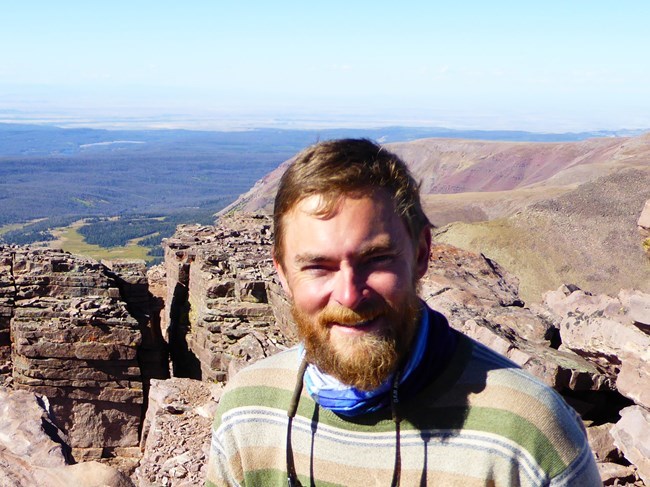
Devin Stucki
Devin Stucki started a detail as Interim Vegetation Ecologist with MOJN in early March. His detail will last until early June. Devin is Vegetation Ecologist with Upper Columbia Basin Network (UCBN), and has been collaborating with MOJN on both aspen and white pines monitoring projects, which the two networks have in common. In his detail, he is also assisting MOJN with desert springs vegetation and integrated uplands monitoring projects.At UCBN, Devin has been involved with many of the network’s inventory and monitoring vegetation and vertebrate projects, and started work there in 2008. Previously, he worked for the Bureau of Land Management and the U.S. Forest Service, which included fire effects monitoring, wildland firefighting, and plant surveys. He has a MS in Forest Ecosystems and Society and a BS in Botany, both from Oregon State University.
“MOJN I&M is staffed by fantastic and dedicated people who work in some amazing places," Devin said. "I’m excited by this opportunity to assist MOJN with this temporary detail and I'm looking forward to the continued collaboration between MOJN and UCBN on a number of important projects.”
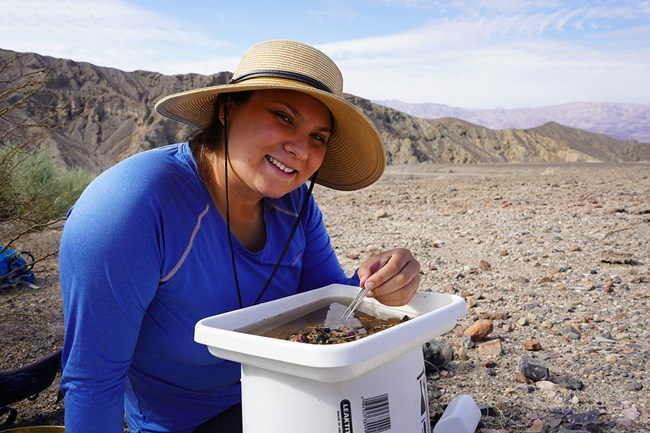
NPS / Jennette Jurado
Clarice Wheeler
Clarice started working with MOJN in October as a Physical Science Assistant with the Conservation Legacy program. She conducted desert springs and selected large spring monitoring in MOJN parks. Previously, Clarice worked for various agencies and nonprofits around the Mojave, Great Basin, and Sonoran Deserts. She worked on soil and vegetation surveys in southern and central Nevada, assisted with watershed resource projects in southern Arizona, and managed environmental education and interpretation programs at Clark County Wetlands Park. Clarice has a BS in Earth and Environmental Science from the University of Nevada, Las Vegas. She will be leaving in mid-May and has accepted a permanent, full-time position as program coordinator for Friends of Nevada Wilderness.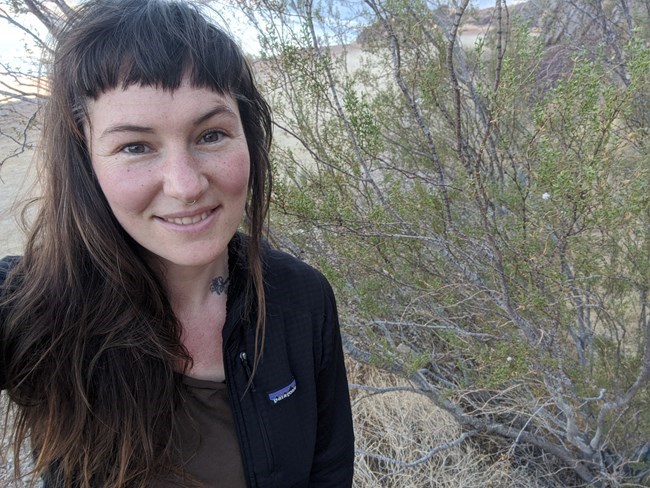
Lee Pipkin
Lee Pipkin joined the network in late January as a Biological Science Assistant with the Conservation Legacy program. She primarily assisted with the integrated uplands and desert springs vegetation monitoring projects. She occasionally assisted with monitoring of bats and desert springs. Previously, she worked as a biological science technician on a bird and bat mortality survey for U.S. Gelogical Survey in Palm Springs, a wildlife technician for Alaska Fish and Game, a botany field technician for the University of Idaho’s Stillinger Herbarium, and a riparian botanist for the Montana Natural Heritage Program in northwest Wyoming. Lee received her A.S. in Desert Ecology at the College of the Desert in the Coachella Valley and a BS in Natural Resources (emphasis in Botany and Plant Ecology) at Oregon State University. Lee’s internship ended in late April. This fall she will be starting a graduate program in Botany at the California Botanic Garden with Claremont Graduate University.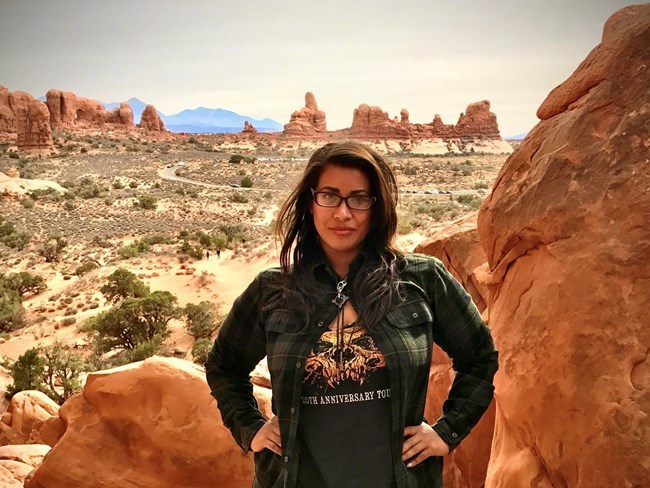
Flor Calderon
Flor began working with MOJN in January as a Great Basin Institute Biological Science Technician for the bat monitoring project. She helps with acoustic bat monitoring and white-nose syndrome surveillance. This season has been very successful with bat captures to swab for white-nose syndrome. She also assists occasionally with vegetation and springs monitoring. Flor previously worked as a bat technician for the Wyoming Game & Fish Department which led to several positions within the Department monitoring grassland bird species, small mammals, and the black-footed ferret. Before joining the MOJN team, she worked as a technician researching the Hawaiian hoary bat for USGS on the big island of Hawaii. Flor obtained her BS in Wildlife, Fish, and Conservation Biology at the University of California, Davis. She is working with MOJN through June and will move on to a position as a crew lead monitoring bats with Oregon State University.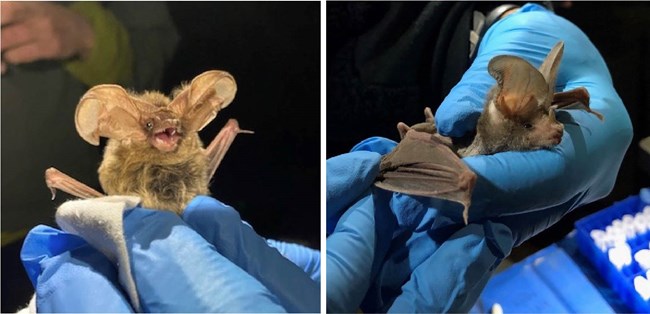
Photo by: Flor Calderon
I have been in bat bliss this season as we have been able to swab over 100 bats for the white-nose fungus and I’ve been able to handle a few species that I’ve never seen including Allen’s big-eared bat and the California leaf-nosed bat.
Spring and Summer Field Schedule
| Protocol | Apr | May | Jun | Jul | Aug | Sept |
|---|---|---|---|---|---|---|
| Aspen | – | – | – | – | GRBA | – |
| Integrated Uplands | – | GRBA | GRBA | GRBA | – | – |
| Spring Vegetation | DEVA | – | – | – | – | – |
| White Pine | – | – | – | – | – | GRBA |
| Desert Springs | PARA | – | – | – | – | – |
| Selected Large Springs | – | – | LAKE, PARA, JOTR, MOJA |
– | – | LAKE, PARA, JOTR, MOJA |
| Streams and Lakes | – | GRBA | – | – | – | GRBA |
| Bats | Capture: PARA, DEVA, MOJA, JOTR |
Acoustics: PARA, DEVA, MOJA, JOTR, LAKE |
Acoustics: PARA, DEVA, GRBA |
– | – | Blitz: DEVA |
Recent Monitoring Briefs or Web Articles
We are producing two-page briefs or summaries of each of our monitoring projects, intended to be a brief overview of the project, or to highlight a recent accomplishment. Following are two completed last fall:
The Streams and Lakes Monitoring Brief summarizes the importance of streams and lakes at Great Basin National Park, threats to these aquatic resources, the monitoring goals and questions, and our monitoring approach, and it highlights management applications.
The web article, White Pines Healthy in Great Basin National Park, was published after the last set of white pine monitoring plots were installed in Great Basin National Park. It highlights that white pines face threats from mountain pine beetles, a warming climate, and the non-native pathogen that causes white pine blister rust. But recent collaborative monitoring documented that surveyed pines are healthy, with no incidence of blister rust infection.
